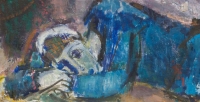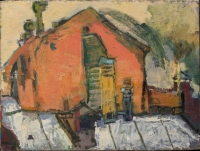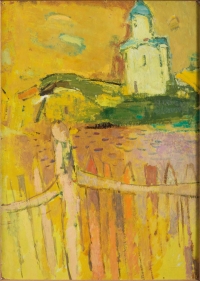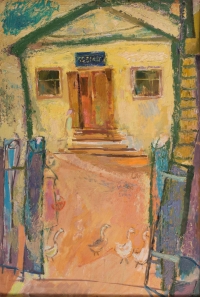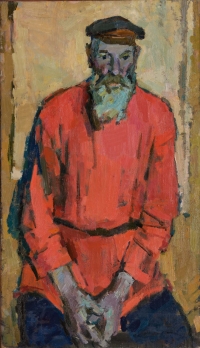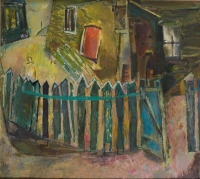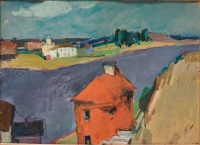BEING AND BEINGS: ART OF FELIX LEMBERSKY
April 24 - May 17, 2013
Pushkin House
5a Bloomsbury Square
London, WC1A 2TA
United Kingdom
Opening Reception Wednesday 24th April 2013, 6.00 – 9.00 pm; at 7.30: Introduction by Yelena Lembersky and reading by Robert Chandler
Lecture Tuesday 30th April 2013, 7.30 pm: Pushkin Club programme: Robert Chandler on Vasily Grossman's AN ARMENIAN SKETCHBOOK (NYRB Classics & the MacLehose Press)
Lecture Tuesday 14th May, 2013, 7.30 – 9.00 pm: Joseph Troncale, Professor of Russian Literature and Visual Studies, University of Richmond, “Art That Stops the Mind and Moves the Heart”
http://www.pushkinhouse.org/single-exhibition/items/being-and-beings-works-by-felix-lembersky
http://www.russianartandculture.com/exhibition-lembersky-pushkin-house-london/
Pushkin House is pleased to present the art of Felix Lembersky (b. Lublin, Poland, 1913; d. Leningrad, 1970), the first showing in Great Britain. Rooted in Soviet Avant-Garde and academically trained in Leningrad, Lembersky melded realist and modernist forms, realigning them to create emotionally charged and thought-provoking imagery, expressed through a masterful technique and exquisitely complex color. His work offers a poignant view of life and the role of an artist as the voice of the people. A contemporary and friend of Dmitri Shostakovich, Natan Rakhlin, and Vasily Grossman, Lembersky was part of the subversive high culture that created a viable alternative to state-mandated art.
Lembersky was a painter, set designer, teacher, creator of artistic groups and a vocal proponent of freedom in art in the Soviet Union. His visual context is grounded in Poland, where he was born; in Ukraine, where he was raised; in Leningrad (St. Petersburg), where he lived; and in other cities in Russia and the Urals. He became a refugee at the onset of World War I, grew up in the crucible of the Bolshevik Revolution and the Civil War, and lived through World War II, including the Siege of Leningrad and the murder of his parents in occupation. He studied in Kiev from 1928 to 1934 and in Leningrad, at the Academy of Art from 1935 to 1941, graduating in the besieged city in December, 1941.
Lembersky's work has appeared in major exhibitions in Leningrad, Moscow, Sverdlovsk (Ekaterinburg) and Nizhny Tagil. Recent solo exhibitions were held in the United States: Massachusetts, Virginia, Wisconsin, and in Russia. Most recent catalogues include Torn from Darkness. Works by Felix Lembersky (Richmond: University of Richmond, 2011), Felix Lembersky. Paintings and Drawings (Moscow: Galart, 2009, in English and Russian) and Feliks Lemberskiy. Proekt “Tvortsi Uzniki Sovetsi” (Nizhny Tagil: Nizhny Tagil Art Museum, 2009). His work is in the holdings of art museums, including the Russian Museum (St. Petersburg) and Dodge Collection of Soviet Nonconformism at Zimmerli Art Museum (Rutgers University).
Highlights of this exhibition include one painting from Lembersky's series of works about Babi Yar, the ravine outside Kiev where the Nazis massacred up to 80 000 people , (oil on canvas, ca. 1944-1952), “DOM POSLE BOMBEZHKI,” (“Building after Bombing," 1959, oil on board) and “LEZHASCHAYA. The Siege of Leningrad,” 1964, oil on canvas). Despite the painful historical events he addresses, Lembersky asserts life though beauty, empathy, and shared humanity. His most moving images are of people coming out of the shadows of catastrophe, who, nonetheless, find inner resources to seek meaning. His landscapes transform nature and man-made structures into living participants in his work reflecting on a continuum of life and spiritual awakening.
This exhibition is the result of international collaboration between Pushkin House and Pushkin Club (London) and the Uniterra Foundation (Cambridge, Massachusetts). It is curated by Robert Chandler, Elena Zaytseva and Yelena Lembersky, with consulting Joseph Troncale, Professor of Russian Literature and Visual Studies and Masha Karp, independent journalist based in London. The exhibition is sponsored by Pushkin House, Pushkin Club, the Uniterra Foundation, anonymous donor, Mia Dubosarsky and Roy Katz, Anna Lublinsky, Vitaliy Slobotskoy, Andrea Strimling and Tsering Ngodup Lama Yodsampa, Mikhail and Yelizaveta Vaynshteyn, Andrew Richard, Mariya Yevsyukova and Alena Zavadskaya.


